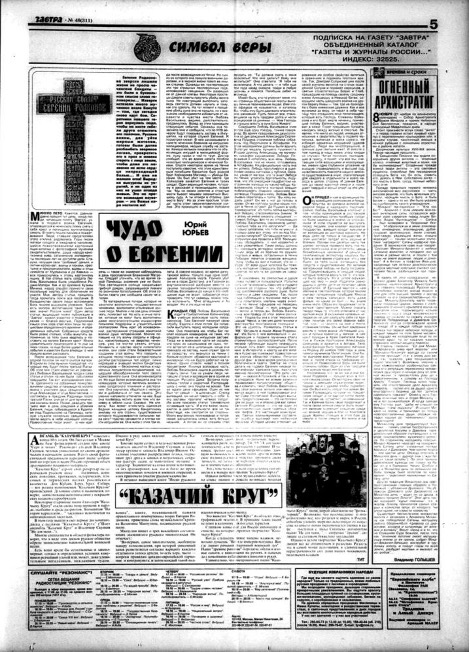Filed Under: Print > Journalism > The Miracle of Evgeny
The Miracle of Evgeny
[2 items]
On 14 February 1996, eighteen-year-old Russian border guard Evgeny Rodionov, along with three colleagues, stopped an ambulance passing the checkpoint where they were serving during the First Chechen War. What they didn’t know was that the ambulance was carrying weapons at the behest of Chechen military leader Ruslan Khaikhoroev (1963-1999). When they attempted to search the vehicle, all four Russians were taken prisoner. After subjecting them to three months of torture, their Chechen captors—according to accounts published later—gave them the choice of their life or their faith. “He had the choice to stay alive,” his killer later recounted for Pravda. “He could have changed his faith, but he didn’t want to take off his cross. He tried to escape…” Rodionov was beheaded. When his mother was finally allowed to see his body, she was able to identify it only by the cross still hanging from a chain around his neck.
Although the story was known at the time, it wasn’t widely reported until 1999, when the early rumblings of the Second Chechen War made the topic relevant once again. In a series of articles in the far-right newspaper Zavtra (Tomorrow), Yuri Yuriev recounted Rodionov’s death in sensationalist and often racist tones calculated to stoke vengeful support for the coming war. In a follow-up from 1999, Yuriev recounts the “mountains of mail” he received in response to the first story, then quickly moves on to something more mystical. After Rodionov’s mother gave her son a proper burial, he started appearing to her in dreams, saying that he would find rest only after the “third Easter from his death.” Sure enough, Yuriev writes, the next time people gathered to commemorate his death, they saw the sun shimmering in the sky. “Orthodox people know what that means. Just such a portent was seen on the day of the glorification of the Blessed Matrona Nikonova.”
Yuriev was not the only one to report miracles connected with the deceased Rodionov. In 1999, Father Vadim Shkliarenko from Dnepropetrovsk reported reading a brochure about Rodionov’s story, then seeing him in a vision that night “in camouflage, just like in the brochure, but with a red cape cast over his shoulder like the ones in which martyrs are rendered on icons.” The next day, Father Shkliarenko saw that “the front of the brochure with the portrait of the neomartyr for Christ, the warrior Evgeny, was sprinkled with drops of myrrh that sparkled in the morning sun.” The brochure “miracle” helped feed an intensive campaign to canonize Rodionov in the coming years. Father Shkliarenko’s vision served as the basis for many icons of the “Martyr Warrior Evgeny” throughout the Orthodox world. Rodionov’s canonization campaign brings to the fore the religious and racial overtones of the war in Chechnya. Officially a war for the political integrity of the Russian Federation, it also became a cultural crusade for the “Christian purity” of the Russian nation.
Although the story was known at the time, it wasn’t widely reported until 1999, when the early rumblings of the Second Chechen War made the topic relevant once again. In a series of articles in the far-right newspaper Zavtra (Tomorrow), Yuri Yuriev recounted Rodionov’s death in sensationalist and often racist tones calculated to stoke vengeful support for the coming war. In a follow-up from 1999, Yuriev recounts the “mountains of mail” he received in response to the first story, then quickly moves on to something more mystical. After Rodionov’s mother gave her son a proper burial, he started appearing to her in dreams, saying that he would find rest only after the “third Easter from his death.” Sure enough, Yuriev writes, the next time people gathered to commemorate his death, they saw the sun shimmering in the sky. “Orthodox people know what that means. Just such a portent was seen on the day of the glorification of the Blessed Matrona Nikonova.”
Yuriev was not the only one to report miracles connected with the deceased Rodionov. In 1999, Father Vadim Shkliarenko from Dnepropetrovsk reported reading a brochure about Rodionov’s story, then seeing him in a vision that night “in camouflage, just like in the brochure, but with a red cape cast over his shoulder like the ones in which martyrs are rendered on icons.” The next day, Father Shkliarenko saw that “the front of the brochure with the portrait of the neomartyr for Christ, the warrior Evgeny, was sprinkled with drops of myrrh that sparkled in the morning sun.” The brochure “miracle” helped feed an intensive campaign to canonize Rodionov in the coming years. Father Shkliarenko’s vision served as the basis for many icons of the “Martyr Warrior Evgeny” throughout the Orthodox world. Rodionov’s canonization campaign brings to the fore the religious and racial overtones of the war in Chechnya. Officially a war for the political integrity of the Russian Federation, it also became a cultural crusade for the “Christian purity” of the Russian nation.
